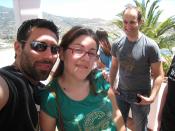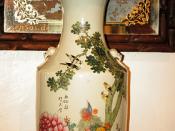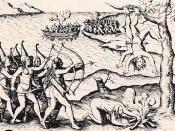The Greeks and the Chinese have fashioned thousands of different art pieces throughout the centuries, be it pots, vases, statues, paintings, and so on. Some art pieces can be very detailed, while others can be extremely simple. Some art may look realistic, perhaps to the point of looking like it is actually living, while others may not be so realistic or life-like looking. In this paper are also three detailed descriptions from three different pieces of art; two from the Greeks and one from the Chinese.
It is probably common knowledge that Greek art is more fluid and relaxed than some other art pieces from, say, the Egyptian culture, which has a more rigid and stiff appearance to some of its figures. The Greeks have learned to be able to sculpt figures that are in restful, relaxing postures and/or positions. When looking at a Greek statue of a human, one may find that the Greek figure will have its shoulders relaxed and standing in a restful standing posture, giving the statue a backward "S" appearance.
However, this is not usually the case with some art made by the Egyptians. When looking a statue of a human made by an Egyptian, one may find that the shoulders are broader and more parallel to the ground, the chin tilted slightly upward, the knees and elbows locked, and the body in a stiff, straight position. This is an example of how Greek art is more fluid and relaxed than Egyptian art.
Some pieces of art can seem life-like and portray something that once existed realistically, but for a piece of art to seem alive will need a lot going for it. What I mean by that is that the piece of art must look realistic. For a piece of art to seem alive,


